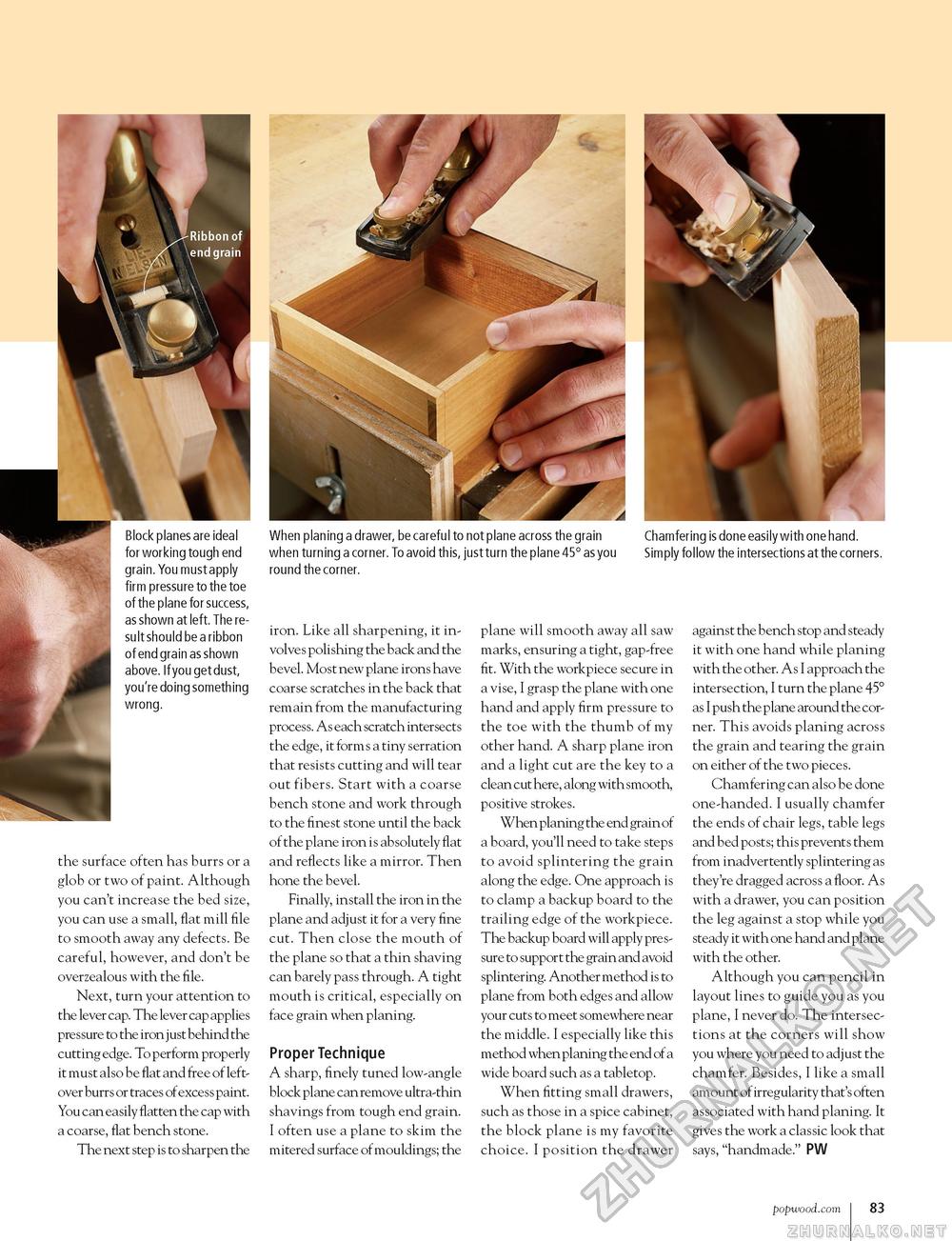Popular Woodworking 2004-10 № 143, страница 86
Block planes are ideal for working tough end grain. You must apply firm pressure to the toe of the plane for success, as shown at left. The result should be a ribbon of end grain as shown above. If you get dust, you're doing something wrong. When planing a drawer, be careful to not plane across the grain when turning a corner. To avoid this, just turn the plane 45° as you round the corner. Chamfering is done easily with one hand. Simply follow the intersections at the corners. the surface often has burrs or a glob or two of paint. Although you can't increase the bed size, you can use a small, flat mill file to smooth away any defects. Be careful, however, and don't be overzealous with the file. Next, turn your attention to the lever cap. The lever cap applies pressure to the iron just behind the cutting edge. To perform properly it must also be flat and free of leftover burrs or traces of excess paint. You can easily flatten the cap with a coarse, flat bench stone. The next step is to sharpen the iron. Like all sharpening, it involves polishing the back and the bevel. Most new plane irons have coarse scratches in the back that remain from the manufacturing process. As each scratch intersects the edge, it forms a tiny serration that resists cutting and will tear out fibers. Start with a coarse bench stone and work through to the finest stone until the back of the plane iron is absolutely flat and reflects like a mirror. Then hone the bevel. Finally, install the iron in the plane and adjust it for a very fine cut. Then close the mouth of the plane so that a thin shaving can barely pass through. A tight mouth is critical, especially on face grain when planing. Proper Technique A sharp, finely tuned low-angle block plane can remove ultra-thin shavings from tough end grain. I often use a plane to skim the mitered surface of mouldings; the plane will smooth away all saw marks, ensuring a tight, gap-free fit. With the workpiece secure in a vise, I grasp the plane with one hand and apply firm pressure to the toe with the thumb of my other hand. A sharp plane iron and a light cut are the key to a clean cut here, along with smooth, positive strokes. When planing the end grain of a board, you'll need to take steps to avoid splintering the grain along the edge. One approach is to clamp a backup board to the trailing edge of the workpiece. The backup board will apply pre s-sure to support the grain and avoid splintering. Another method is to plane from both edges and allow your cuts to meet somewhere near the middle. I especially like this method when planing the end of a wide board such as a tabletop. When fitting small drawers, such as those in a spice cabinet, the block plane is my favorite choice. I position the drawer against the bench stop and steady it with one hand while planing with the other. As I approach the intersection, I turn the plane 45° as I push the plane around the corner. This avoids planing across the grain and tearing the grain on either of the two pieces. Chamfering can also be done one-handed. I usually chamfer the ends of chair legs, table legs and bed posts; this prevents them from inadvertently splintering as they're dragged across a floor. As with a drawer, you can position the leg against a stop while you steady it with one hand and plane with the other. Although you can pencil in layout lines to guide you as you plane, I never do. The intersections at the corners will show you where you need to adjust the chamfer. Besides, I like a small amount of irregularity that's often associated with hand planing. It gives the work a classic look that says, "handmade." PW popwood.com 83 |








